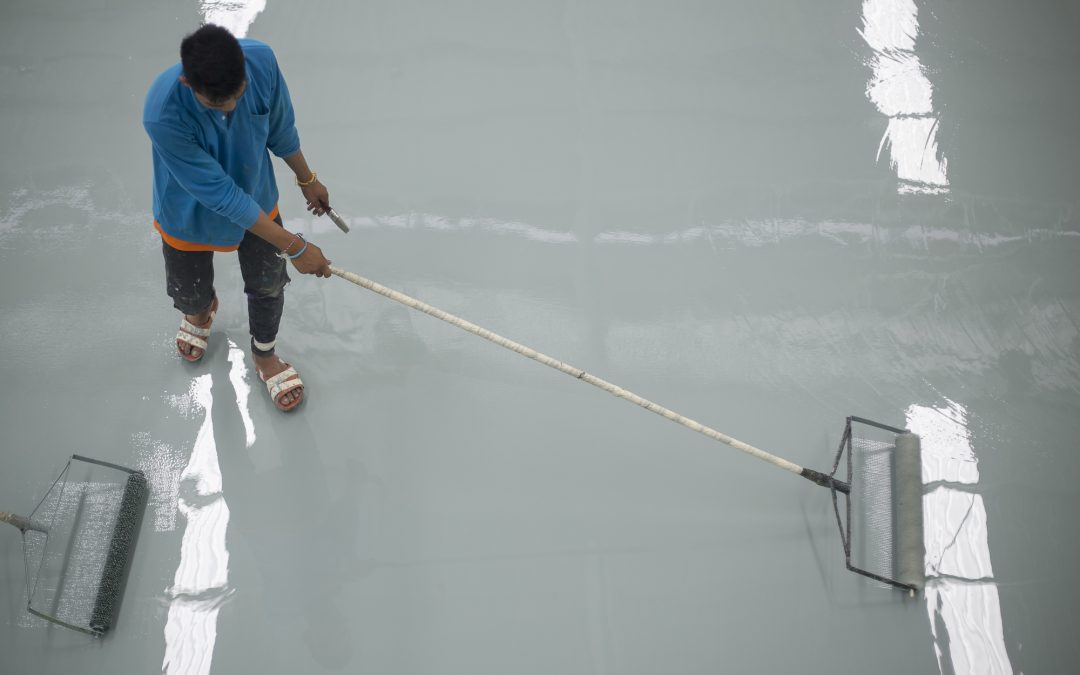Epoxy has been changing the way we live for over 75 years, but there’s a (relatively) new contender in town—when it comes to floor coatings.
In 1987, Texaco Chemical Company created polyurea as a spray-on coating for industrial surfaces and patented it in 1988. It didn’t take long for the industrial community to be enamored by the durability and usefulness of the product.
Skip to the mid and late 1990s, and the very first non-industrial uses of polyurea were coming around. It seems like only in the past decade though that a lot of people noticed the battle going on between epoxy and polyurea floor coating technologies.
Does it matter which you use? Keep reading to find out!
Polyurea: Superior Strength
While Epoxy is technically “harder” than polyurea coatings, much of polyurea’s impact resistance is due to its flexibility. It moves with concrete as it expands and contracts in winter and summer, as well, reducing damage to the coating.
Due to its thermal and chemical stability, it won’t stick to hot tires after a long day of driving on hot asphalt and peel off.
For industrial warehousing, home garages, and patios, nothing beats the durability of polyurea. This durability is one reason that polyurea was introduced first in industrial applications.
With polyurea floor coatings, you can be assured that you have the strongest available protectant for your concrete.
Quick-cure Properties
Polyurea is quick to cure, without harmful VOCs. While epoxy floor coatings could take days to dry and cure, polyurea coatings dry within minutes and are done curing by the next day.
Long cure times allow for bubbles to form in epoxy, which doesn’t happen with polyurea. Bubbles will cause integrity issues with your coating, leaving it open to damage.
Because epoxy is a thermosetting polymer, it also can’t be installed in extreme temperatures. Though, you can apply polyurea coatings in temperatures ranging from -30° to 140°F.
This means you can coat your floors outside of the “sweet spot” of spring and fall.
UV Stable
While epoxy yellows and turns amber with exposure to UV (ultraviolet) light, polyurea is 100% UV resistant.
While normal epoxy without a UV resistant coating can yellow within 24 hours, epoxy flooring starts to yellow between six months to a year with daily exposure. Because sunlight doesn’t hit a surface evenly every day, at the same intensity, and for the same amount of time, it yellows at different rates.
With polyurea flooring, you don’t have to worry about your new, beautiful floors turning strange colors due to yellowing.
Anti-slip
Polyurea coatings have an additional anti-slip clearcoat. This gives it a high-gloss finish that looks good while being safe for your family, employees, and customers.
Slip and fall accidents are a leading worker’s compensation claim, so you can even be saving yourself money and liability as a company. Slippery floors directly contribute to over 2 million fall injuries a year, with the total cost of injuries costing up to $14 million.
It isn’t about the dollars and cents, in the end. It’s more about peace of mind, especially if you have older ones using a patio surface.
Chemical Stability
Because polyurea is chemically stable, it resists corrosion, oxidation, and moisture. It’s chemically resistant to salts, oils, fuels, and grease. This is great news if you’re a DIY car mechanic for your family.
An issue with some epoxy is that moisture can seep into the space between the concrete and the epoxy coating. While this is never good, it is especially bad in winter, when it can freeze and damage the concrete and the coating. This is not an issue with polyurea floor coatings.
Again, the inherent qualities of polyurea’s durability against chemicals were it’s leading industrial applications. Its use in tanks and containers to prevent corrosion is proof that it will work well on your floors for many years to come.
The takeaway is that polyurea coatings have great looking finishes that won’t stain, bulge, crack, or chip under circumstances epoxy would.
Incredible Decorative Variety
At Garage Force, we offer a large variety of color options and textures.
Epoxy simply can’t compete with the versatility of polyurea floor coatings, used in systems such as quartz, stone series, and other designs.
Our Medici® polyurea color coating system gives a decorative finish that beats any acrylic or acid stain system for durability and appearance. It doesn’t react with the minerals in the concrete or its integrity. It won’t chip, fade, or dull over time.
If fancy decorative textures aren’t your thing, solid color options may be an option, available with the same excellent durability properties as the rest of the lines.
Polyurea Floor Coating: It Matters
While epoxy might be tried and true, polyurea is the wave of the future of floor coating technologies. With anything relatively new, there are increased costs.
The benefits of polyurea are definitely ahead of epoxy. Your polyurea floor coating may even outlast your home or roof!
Polyurea floor coatings are durable enough for commercial grade corrosion and impact resistance. They’re also ideal for protecting your concrete garage and patio floors for decades to come, without yellowing. It doesn’t matter if it is in winter, summer, spring, or fall, your polyurea coating will hold up.
With the addition of being anti-slip, and beautiful, there’s no reason not to look into a floor coating for your garage or patio space.
Interested in learning more about polyurea floor coating for your garage and patio floors? If you’re trying to find out what your needs are, don’t wait—get in touch with us today!

